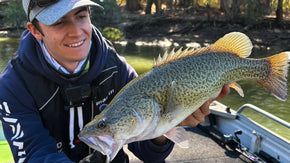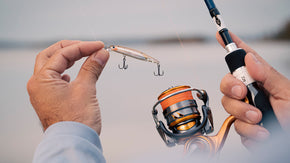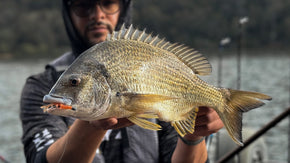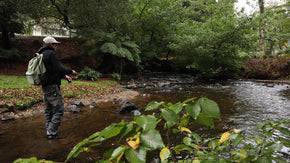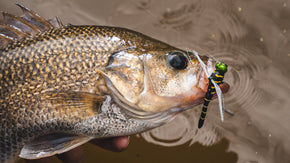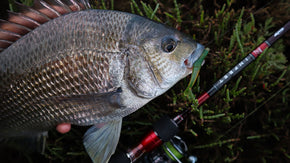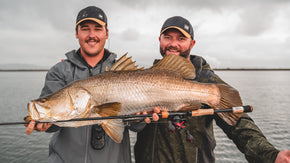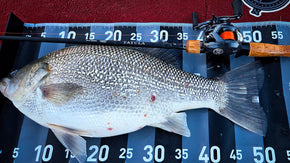Posted 07th February 2025
Hobie Fishing Australian Championship 2024


By Joshua Bland
Prologue
The sound of the cicadas was deafening, their high-pitched shrills reverberated down my spine. The air was wet. I’ve experienced this humidity before, but the combination of heat and the stillness of morning was sapping my strength faster than I’m used to. Hands wet with sweat; I fumbled for my kayak’s rudder control as I weaved my way around the mangroves buzzing with tiny vampires. Beneath them, the water rippled with distinct shapes cutting between the trees.
I rocketed in a pink grub that skipped across the water like a stone, evading the denseness of the canopy above and coming to rest at the mangrove’s trunk. Reeling fast, I watched the plastic tail kick rapidly side to side as the lure navigated the maze of aerial roots. Behind it, from the shadows, a bow wave with increasing momentum charged on the escaping bait. A distinct blue-grey nose broke the water’s surface, backed by a gape of pearlescent teeth. I watched as the glow of the pink grub vanished, like a flick of a light, as the fish inhaled its meal. The water erupted in chaos, sending saltwater spraying in all directions. The animal rolled its body, exposing its blinding silver flank and for the first time, I laid eyes on it. This was the fish I drove 1,800 kilometres to catch…
No place like home
Of all my travels around Australia, there’s one state I had yet to visit with any great seriousness. For some reason, the east coast of NSW, home to over 35% of Australia’s population has avoided me. It might be because I have family in most other parts of Australia and holidays have always pushed me elsewhere. However, the results of the 2024 Bream Master South Australia tournament series put in motion a reason to go that I wasn’t going to pass up.
Up in the timber-laden upper reaches of the Onkaparinga River, I hooked into a fish that changed the course of my year forever. As the battle came to its end, the fish admitted defeat and a whole 1 kg of southern black bream entered my net. Not only did this solidify the Angler of the Year title for our South Australian tournament series, but it also bought me a ticket to the biggest kayak fishing tournament in Australia, the Hobie Fishing Australian Championship.
The Australian Championship collects 50 of Australia’s best-performing anglers from the Hobie Fishing circuit across the year. From top-placing anglers to consistent performers, every person at this event knows how to catch big bream. I was a bit of a stow-away. Having only competed in one Hobie event for the year in Glenelg River, I was nowhere near having enough points to even be considered. However, Hobie generously offered a single ticket to the championship to whoever took out Angler of the Year for the Bream Master SA series. Fortunately, after performing consistently across our South Australian venues, I managed to come on top.
The 2024 Australian Championship took us to Camden Haven. A network of large estuarine lakes that neighbour the main Camden River. This estuary, like many along the east coast, has a reputation for strong currents and challenging fishing. Though it does hold the Australian record for yellowfin bream at 4.45 kg, fish of that calibre are few and far between. With four days of fishing pressure, the challenge was only going to intensify each day. This meant that it was anyone’s game and that consistency above all else would triumph.

What came before
I had a plan. Weeks leading up to the event I had done my research, listening and reading anything I could find on the system. Scouring Google Earth I identified spots too good for the fish to pass up and began to construct a plan. The evidence was strong that the front of the system was a big fish zone, but the strong currents made it a formidable area. One that is potentially disastrous for the uninitiated, in other words – me. It was a high-risk move. I am I diverse angler but unfamiliar with this place and questions of whether I could handle it plagued my mind.
On my way up I caught up with a few fellow anglers, all forthcoming with advice and stories about chasing yellowfin bream. I have caught one yellowfin bream before, no larger than my palm from the Currumbin River when on holiday in the Gold Coast years ago. These were my days before tournament fishing and looking back on it, I was still largely clueless. The memory of what it was like to catch one was lost on me so I was willing to take on board any advice I could get. Through discussion, I realised I was well-practised with most of the effective techniques, but the environment remained unfamiliar. So, I decided to leave the front of the system alone on prefish in search of other options.
Prefish
I watched the fish flip around over and over in my kayak. I couldn’t believe the persistence of the species compared to the black bream back home. This fish did not want to settle and was fighting me to the end, covering my hand in bloodied punctures. This fish, however, filled me with confidence and broke down any preconceived doubts I may have had. I was ready to fight for this title.
I continued to fish surface lures through the mangroves and found some areas holding good fish, making sure to pull the lure away fast enough so that I could see them without hooking them. One area I wanted to check out was the upper reaches of the system in the Camden River. With yellowfin bream spawning complete, I figured it would make sense for them to have ventured up that way. So, I set out on the additional five-kilometre peddle towards the river.
Upon entering the river, I was surprised at how much more comfortable I was. It had a familiarity about it, reminiscent of the rivers I grew up fishing. Fallen timber dotted the banks, and overhanging trees offered the promise of falling insects to the fish below. Cicadas continued to belt their song as I meandered up the river. Digging through my tackle box, I found my cicada lure that I had bought some four years earlier. Safe to say it has remained rather dry since then.
I began to get my eye in. Casting the lure close to the timber or under the trees gives it small twitches to invoke a reaction. It had to land nearly touching the bank or they weren’t interested. It always surprises me how tunnel-visioned bream can be to the point they won’t acknowledge food sitting a few feet away from them. The pattern started to become clear, but one thing continued to bother me. The hookup rate was abysmal. Though a good thing on prefish, it was highlighting an issue I had to fix. After 10-15 takes, I only had two fish to come of it, both of which were not much larger than legal size.
Day one
Conditions had changed. The bright sun and heat of the day before had been overthrown by cloud cover and the threat of rain. The humidity and stillness were about all that remained of the day prior. With my newfound confidence in the mangroves, I abandoned my original plan of fishing the mouth. I figured it would be better to get a bag than the risk of none at all. The river on the other hand was a 10-kilometre peddle up the system, a long way to go to miss multiple fish. Mangroves it is.
Cast after cast I pepper the mangroves covering front to back with the pink grub the same as the day before. Only today something was different; the fish weren’t there. The change in conditions overnight had also changed the behaviour of the fish and they were no longer holding in the trees. But I was persistent. Changing lures, covering ground, even fishing the neighbouring oyster racks for not much interest. By mid-morning I had nothing to account for the effort and mind games were beginning to set in. Why aren’t they here? Am I throwing the wrong lure? Other people probably have a bag by now... Maybe I’m worse than I thought... It began to weigh on me.
I ran into Dylan Pace, who is well known for the consistency he brings to arenas across the country, as he landed a fish from a precarious cast beneath a floating rack. He was only now starting to catch a few and had also noticed the change in fish behaviour. With racks now producing decent fish with traditional structure fish techniques. This helped me battle my doubt in two parts. Not only am I not alone in finding it more challenging today, but the fish are there to catch, you just need to work it out. So, I left Dylan to the racks in search of my own solution.
I pulled out Google Maps and zoomed into the lake not too far from my location – Watson Taylor. The lake is known for reliably producing bream on the flats; a style of fishing I’m familiar with. With such as big area to cover and very little time, I identified an island that neighboured the main channel and dropped a pin on the down-current side. A classic ambush area for fish. I tied an Infeet Rollin’ Crank in Clear Gill onto my Infeet Z 742ULRS loaded with straight-through 3lb J-Thread Finesse FC and got to work.
Upon arrival, the activity was startling. Baitfish and prawns skipped around the eddies made by patches of cockle weed. Watching the occasional swirl, I recognised these were bream. I lobbed my first cast up current, past the boiling activity and began to crank it down. The bib chewed along the sandy bottom, the vibrations of its action pulsating through the line. Immediately the rod tip is yanked forward as a fish takes the lure. The rod buckled over, its softness absorbing each lunge the fish took in a vain effort to escape. As the fish approached the kayak it made a mad dash for the power pole in an attempt to slice the line. But I was warned of this. Standing up, I leant into the parabolic action of the rod and held the fish from danger. Exhausted, the fish slid across the surface and into the net. One down.
My second fish followed soon after, but I then began to struggle. I filtered through large whiting and flathead each of which tried with their might to take my last Clear Gill crankbait. Repositioning, I tried a new angle casting into the weed patches. As I cranked down the lure quickly got snagged; trapped by the weed. But, unlike back home the lure in this weed pulls out. Popping the crankbait out with the rod I am suddenly met with a strike from my biggest bream of the day. Its lunges drew a little line each time – I knew I needed this fish. To my fortune, it came in relatively easily and rounded out my bag. I breathed a sigh of relief.
Making my way back to the ramp I fished a few rock walls being ripped by the current. I swapped to the deeper diving crankbait the Infeet Spike 44EXDR in Ghost Perch. This was a bit different from the flats, cranking it down deep quickly to then crawl it across the rocks. I managed a final fish for the day a couple of grams heavier than my smallest doing this. After previous wins here being a matter of 20 grams, anything helped. My bag came in at 1.05 kg. a low bag size for the arena but a three-fish bag, nonetheless.

Day two
As the forecast predicted, conditions changed again. This time, full sun and moderate winds; very similar to prefish. Peddling up the system I could feel and hear the difference. The insect activity that was deathly quiet on day one had turned to a cacophony of buzzing and shrills. I decided to go up the Camden River at the top of the system. This time armed with a few tricks. I spent the night adding a second split ring to the treble hooks of my cicadas. That way they hang lower and have more articulation in the hope they’ll have a better chance of pinning fish. I also picked up a second cicada choosing to add a Daiwa Retro Fit Assist Hook to the belly in case the double treble configuration didn’t cut it.
As I approached the mouth of the river where it enters the lakes, the current was flowing well carrying new water and food into the system. I made my first cast with my smallest popper an old Gomoku I use on whiting back home. It lay motionless beside a fallen branch for a few seconds before being sucked from sight. I lifted the rod and entered battle with a reasonable bream. After a quick fight, I had a fish a little over 400 grams in the well. This was a great start considering day one.
Fishing my way up the river I targeted the best structure without too much success. The first cast fish curse appeared to cloud the popper. Call me superstitious but it was time to switch. I swapped it out for my double treble Tiemco Cicada tied onto my favourite structure rod, the Infeet Z 681LFS. I paired with the new 24 TD Black loaded with J-Braid Expedition braid and an 8lb X-Link FC leader to make sure I could muscle any big fish out of cover. Nothing was getting away.
The shortness of the rod made casting into the tight areas a breeze. Working along the river, I pitched into the small eddies or edges behind the reeds and timber. Each good cast was met with a fish boiling on it. It wasn’t long until I had a bag a little bigger than the day before. All I was missing was good upgrades. I was creeping upwards in weight but not substantially and the bite was growing quiet.
Confused, I looked to the other bank of the river. For the 2 kilometres I had travelled I had yet to try it. Approaching this new bank I wasn’t convinced. When fishing for bream at home a bank in full sun wouldn’t be my first choice. My first cast went too far, tangling with the reeds on the water’s edge. Shaking the rod, I popped it out and into the water. Where it bobbed for a moment before being crunched by a bream. This was an upgrade in the tens of grams, better than nothing. But a few more casts in and it was clear there were more fish on this side.
My time was running out and I still had about 90 minutes of travel time to return to the ramp. With an eye on the time, I pushed a little further. Up ahead was one of the largest fallen timbers I had seen, an intricate web of leaves and twigs. The cicada skipped into the chaos, twitching its way out in a desperate attempt to escape. It pauses… Slap! Jaws crush it from below and begin to drag it towards cover. I immediately grab the spool to prevent it from gaining any line, the strong blank of the rod stopping the fish in its tracks. This is the biggest one of the two days, and I can’t afford to lose it.
This one was angry, and it didn’t want to cooperate. The fish and I were in a tug of war dangerously close to a structure that could slice my line in half. With my one free hand, I pulled on the reverse cable, peddling my feet quickly to back this fish out with the kayak. Now that I had the momentum, I had the advantage. As I pulled into the middle of the river, it was game over. Now playing the fish gently, I could back the drag off and guide it into the net. At over 550 grams this was a critical upgrade.
Time was now running out. Peddling my way back was harder work with a full live well. At this point, I was happy I had given myself a 30-minute buffer. I pulled into the ramp with 15 minutes to spare and joined the queue for weigh-in. My bag came in at 1.37 kg, much better than the day before and allowed me to jump a few positions now sitting in the high 30s.
Day three
The weather had turned for the worst. Strong winds and a storm on the horizon saw the Hobie team reduce the fishing time and push the start time forward in an effort to avoid the worst of it. The tides had also lined up so that going long distances meant you were battling both current and wind. This, I didn’t want to do. Exhausted from the days prior travelling over 20 kilometres each day, I decided to leave the Camden River and focus on bridges in the main channel with the hope it hadn’t been overlooked. After an hour or so of effort and not a bite to show for it, I decided it was the wrong call and turned to head up the channel towards Queens Lake, an area I had yet to explore.
As I peddled up the channel, I was met with a cornucopia of structures lining the banks from fallen boulders to whole trees. This was very similar to what I was fishing up the river, so the cicada came out to play. The current was strong here. I worked hard to hold position whilst drifting up the channel, pitching the cicada into an eddy or structure I could find. It didn’t take long before I found my first fish. It gracefully slurped the lure down from behind a boulder before giving me a short scrap. This fish was reasonable, a little over 400 grams. Locked in on this technique and focussed. Fishing my way up, the bites were slow but better. The current was proving a challenge and hooking them wasn’t coming easy. I finally snagged a second fish, a near carbon copy of the first. With that, I was happy and ventured into Queens Lake in search of the large fish that were coming out of it.
Ultimately, that didn’t happen. I spent the rest of the day travelling to the far side of the lake to get a bag filler. Nothing but small fish all around. Fortunately, I decided to head back early as once I re-entered the channel the current was pumping. Sweating buckets I powered along, moving at less than 2 kilometres per hour. When I arrived back at launch, I was completely spent, the four days fishing were weighing on my body like a tonne of bricks. I weighed in a 0.99 kg bag to conclude my tournament which put me in 34th place.
What comes after
Overall, I am content with my performance. My goal was to get three fish each day and whilst they weren’t the biggest, I can be happy I achieved that. I guess we all have high expectations of ourselves, even in new venues, that can make a poor outcome tough to swallow. But that’s fishing. Sometimes in the pursuit of perfection, we take these things too seriously and mistakes become easy to make. Should I have stuck with my original plan of fishing the front? The winning bags seem to suggest so. However, it could’ve just as easily been a complete failure. We can’t sit and stew on what could have been. Instead, we can look at our performance and find ways to improve ourselves. Day one I should’ve changed it up sooner. Day three I should have stayed put when I was catching reasonable fish. All these mistakes collect in our memory and serve us to do better. Did I outperform the field? Of course not. But am I a better angler because of it? Absolutely. Being confident in what you do and finding success in failure builds us up to who we want to be. This mentality makes us a better angler and serves us well in life.









